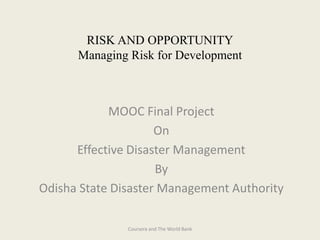Final Project of MOOC in Coursera
- 1. RISK AND OPPORTUNITY Managing Risk for Development MOOC Final Project On Effective Disaster Management By Odisha State Disaster Management Authority Coursera and The World Bank
- 2. October 1999-Orissa cyclone ? A massive cyclone has swept through the state of Orissa in eastern India. ? It became a severe cyclone with a peak of 160 mph (260 km/h) winds, the highest ever recorded in the region.
- 3. Damage caused by the cyclone ? The official death toll then was 9,885 people. ? Of the total casualty, Jagatsinghpur district alone had accounted for 8,119 people.
- 4. Entire villages were wiped out during the cyclone in Orissa
- 5. Aftermath… ? It was learnt that death toll was high in Super Cyclone due to non-availability of safe shelter buildings in the coastal village, which could have withstood the intensity of the cyclone and the storm surge. ? Orissa became the first state in India to set up a disaster management agency – the Orissa Disaster Management Authority (OSDMA). The state government and OSDMA planned and prepared for natural disasters with unwavering commitment.
- 6. ? They identified safe buildings, constructed new shelters, charted evacuation routes, established evacuation protocols and strengthened coastal embankments. ? Most importantly, volunteer teams were set up and mock drills were conducted every year in coastal districts.
- 7. ? From March 2011 onwards, the International Development Agency (IDA) has supported disaster mitigation efforts in Odisha(previously Orissa) as well as in the neighboring state of Andhra Pradesh. ? The $255 million National Cyclone Risk Mitigation Project, Phase I, is the World Bank’s first preventive disaster risk management project in India.
- 8. Phailin Cyclone, 2013 ? Cyclone Phailin struck Odisha’s coast on the night of October 12, 2013, with wind speeds of over 200 km/hour. ? It is of the similar intensity of the 1999 cyclone.
- 9. Rescue Operations ? In one of the largest emergency evacuations in history, over 1 million people were moved to nearby shelters or safer buildings before the cyclone struck. The evacuation was carried out in record time. ? The usually massive death toll was reduced dramatically. Less than 40 people died, in sharp contrast to the cyclone in 1999 which killed more than 10,000 people. ? Major roads were cleared within 24 hours, far sooner than could be expected, as men, machines and materials had been put in place before the cyclone struck, and there was close coordination thereafter.
- 10. ? The World Bank has praised India’s evacuation of nearly 1 million people in Odisha(Orissa) which ensured minimal loss of human lives, before the cyclone Phailin made landfall and attributed it to its years of disaster management preparedness. ? “Successfully evacuating a million people is not a small task. This cannot be merely achieved by kicking the entire state machinery into top gear for three-four days following a cyclone warning,” the World Bank said, days after the cyclone Phailin hit the eastern Indian shore. ? Odisha's handling of the very severe cyclone will be a landmark success story in disaster management," Margareta Wahlstrom, Special Representative of the UN Secretary General (SRSG) for Disaster Risk Reduction said, according to an official of the Chief Minister's Office.
- 11. Lessons learned ? Successful disaster risk reduction can dramatically reduce casualties from natural hazards. The stark contrast in loss of life from the 1999 event and Cyclone Phailin clearly shows the dramatic potential of well-planned and carefully-executed disaster risk management initiatives. ? Resilience is about more than the preservation of human life. Sustainable risk reduction also should aim for the preservation of livelihoods. ? Improved risk insurance instruments are needed to better absorb financial shocks and ensure that reconstruction funds are readily available.
- 12. “The success of minimizing human casualties was due to the resolve of the State and our team’s preparedness. We recognize that each disaster is an opportunity to improve our resilience and risk measures.” — J K Mohapatra, Chief Secretary, Government of Odisha, India
- 13. Thank you…













